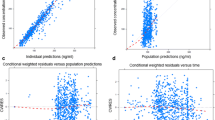Abstract
Background and Objectives
Peramivir, an antiviral agent for intravenous administration, is used to treat progressive influenza in patients with serious complications. The present study was designed to determine the pharmacokinetics of single and multiple intravenous infusions of peramivir in healthy Chinese subjects.
Methods
Single (150, 300 and 600 mg) and multiple (600 mg) doses of peramivir were intravenously administered to 12 healthy Chinese subjects. There was a 7-day washout period between dosing periods. Blood samples were collected in heparinized tubes at various times. Plasma peramivir and urine peramivir concentrations were measured using a high-performance liquid chromatography–tandem mass spectrometry method.
Results
Following single doses of peramivir (150, 300 and 600 mg), the maximum concentration (C max) values were 12,416 ± 3078, 23,147 ± 3668 and 44,113 ± 3787 µg/L, respectively, and the area under the plasma concentration–time curve (AUC) from 0 h to infinity post-dose (AUC∞) values were 24.68 ± 6.48, 47.33 ± 9.22 and 92.43 ± 12.72 mg·h/L, respectively. C max, AUC from 0 to 36 h (AUC0–36) and AUC∞ of peramivir increased proportionally with the dose, and no trend towards accumulation after multiple doses was observed. About 65 % of the peramivir was excreted unchanged in the urine within the first 24 h.
Conclusions
Peramivir pharmacokinetics were dose proportional with increasing doses, with no accumulation after multiple dosing. Peramivir was generally well tolerated, and no serious adverse events occurred.


Similar content being viewed by others
References
Atiee G, Lasseter K, Baughman S, McCullough A, Collis P, Hollister A, et al. Absence of pharmacokinetic interaction between intravenous peramivir and oral oseltamivir or rimantadine in humans. J Clin Pharmacol. 2012;52:1410–9.
Yoshino Y, Seo K, Koga I, Kitazawa T, Ota Y. Clinical efficacy of peramivir in adult patients with seasonal influenza during the winter of 2012 in Japan. Clin Respir J. 2015;9:228–32.
Kakuta M, Kubo S, Tanaka M, Tobiume S, Tomozawa T, Yamashita M. Efficacy of a single intravenous administration of laninamivir (an active metabolite of laninamivir octanoate) in an influenza virus infection mouse model. Antivir Res. 2013;100:190–5.
Matsuo Y, Ishibashi T, Hollister AS, Wajima T. Population pharmacokinetics of peramivir in healthy volunteers and influenza patients. Antimicrob Agents Chemother. 2015;59:6755–62.
Bentley ML, Hollistera AS, Hansenb AC, Smith JA, Cain JS. Peramivir pharmacokinetics in a patient receiving continuous veno-venous hemodiafiltration during the 2009 H1N1 influenza A pandemic. Int J Clin Pharmacol Ther. 2014;52:1105–11.
Zhang D, Du A, Zhang L, Ma J, Meng L, Deng M, et al. Pharmacokinetics of peramivir after single intravenous doses in healthy Chinese subjects. Xenobiotica. 2015;45:239–43.
Clay PG, Adiga RB, Taylor TA, Alsup R, Gerk PM, McRae M. Postpartum pharmacokinetics of peramivir in the treatment of 2009 H1N1 influenza. Obstet Gynecol. 2011;118:463–7.
Zhang D, Du A, Zhang L, Ma J, Meng L, Deng M, et al. Pharmacokinetics of peramivir after single intravenous doses in healthy Chinese subjects. Xenobiotica. 2015;45(3):239–43.
Wang ZZ, Zhang M, Shang DW, Ni XJ, Hu JQ, Qiu C, et al. A rapid LC–MS/MS quantification of peramivir using a simple and inexpensive sample precipitation: application to PK. Bioanalysis. 2015;7:319–32.
Zhao X, Lu M, Zhang YH, Wang LL, Li S, Zhang HL, et al. Pharmacokinetics of peramivir trihydrate and sodium chloride in Chinese healthy volunteers. Chin J Clin Pharmacol. 2013;29:751–4.
Sugaya N, Kohno S, Ishibashi T, Wajima T, Takahashi T. Efficacy, safety, and pharmacokinetics of intravenous peramivir in children with 2009 pandemic H1N1 influenza A virus infection. Antimicrob Agents Chemother. 2012;56:369–77.
Acknowledgments
The authors thank all subjects who participated in this study.
Author information
Authors and Affiliations
Corresponding author
Ethics declarations
Funding
This work was funded by Shanxi Pude Pharmaceuticals Co., Ltd, and the National Natural Science Foundation of China (Grant No. 81403016). Grammar checking support was provided by International Science Editing (Co. Clare, Ireland) and sponsored by the National Natural Science Foundation of China (Grant No. 81403016).
Compliance with Ethical Standards
This study complied with the principles of the Declaration of Helsinki, the Good Clinical Practice: Consolidated Guidelines approved by the International Conference on Harmonization and local Chinese laws on clinical research involving human subjects. The protocols and informed consent form were reviewed and approved by the ethics committee of the Guangzhou Huiai Hospital before subject enrolment. Each subject was informed of the nature and purpose of the study, and provided informed written consent, before the screening procedures were conducted for the study.
Conflict of interest
Li-Zhong Li, who was responsible for the study design and oversight, was an employee of Shanxi Pude Pharmaceuticals Co., Ltd, at the time when the study was conducted. Ming Zhang, Zhan-Zhang Wang, Xiao-Jia Ni, Hao-Yang Lu, De-Wei Shang, Wen-Can Huang and Yu-Guan Wen, who were responsible for conduct of the study and manuscript preparation, were employees of the Clinical Research Unit at Guangzhou Brain Hospital. Doctor Yue-Feng Zhang, Nurse Huan Peng, Nurse Ling-Fang Shen and Nurse Ling-Hui Xiong, who were also responsible for conduct of the study, especially for clinical care, were also employees of Guangzhou Brain Hospital. Ming Zhang, Zhan-Zhang Wang, Xiao-Jia Ni, Yue-Feng Zhang, Huan Peng and De-Wei Shang have received a research grant from the National Natural Science Foundation of China (Grant No. 81403016).
Rights and permissions
About this article
Cite this article
Zhang, M., Wang, ZZ., Ni, XJ. et al. Pharmacokinetic Properties of Peramivir After Single and Multiple Intravenous Infusions in Healthy Chinese Volunteers. Clin Drug Investig 36, 705–711 (2016). https://doi.org/10.1007/s40261-016-0417-8
Published:
Issue Date:
DOI: https://doi.org/10.1007/s40261-016-0417-8




